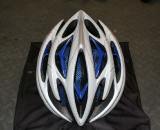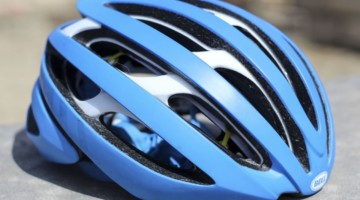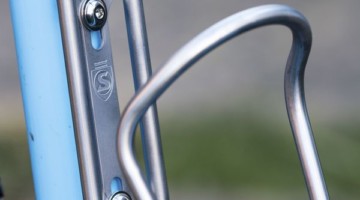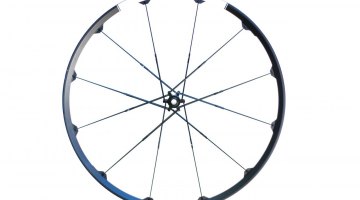by Jamie Mack
Helmets tend to be a very personal choice, with fit sometimes determining the brand a rider prefers more than any other feature. Cyclocross Magazine has tested the latest from one of the major manufacturers of cycling helmets and eye wear in order to give our readers a preview of one of the newest models on the market. The Rudy Project Sterling is the new for 2010, top of the line road helmet from the Italian manufacturer.
The Sterling is available in two sizes—small/medium and medium/large—and is available in an array of color choices. The helmet uses a dial-fit system, a feature common to helmets from other manufacturers as well. Opening the box reveals the helmet, an included soft storage bag and the associated extra pads and paperwork you’d expect. Also available is a removable visor, a nice feature if you’re planning some off-road adventures with the Sterling.
Right out of the box, this helmet is obviously different than other lids. The fit of Rudy Project helmets, including the Sterling, is something that can take a bit of time to get used to. Rather than several foam blocks placed strategically in the helmet to support the structure on your head, the Sterling uses a single large pad. The pad, which is integrated into a bug netting to keep critters out of your hair, covers much more of the head than other helmets—the padding in the Sterling covers the front two-thirds of the head. The configuration can provide excellent comfort, once you’re used to the extra contact. Though the extra material tends to trap more heat, it’s easily removed for machine washing to remove whatever you’ve picked up. The bug netting, which sounds like a gimmick, is a functional piece that will give a measure of relief to the unfortunate ones who’ve had a bee venture into a helmet vent.
Use of composite skeletons to form the foundation of a helmet is a technology used by more than one manufacturer. Rudy Project uses the function of the composite skeleton to strengthen the helmet, but also reveals some of it. The revealed grid retains the impact protection you’d expect, but by removing some of the surrounding material there’s increased airflow through the helmet—noticeably more than other Rudy Project models—and it does provide good cooling effect. The revealed grid also gives the Sterling an interesting, if you’ll pardon the pun, skeletal look.
The increased ventilation afforded by the grid does bring an interesting downside with it. While the airflow is a welcome relief during rides on warmer days, riding on colder days requires an additional layer on the head to avoid the cold—I had something akin to an ice-cream headache half an hour into one excursion. Thankfully the feeling dissipated as I warmed up and started radiating enough heat to fight back the cold, but it’s an unexpected drawback that needs to be considered when wearing the Sterling on milder days.
The Sterling is a bit of a heavyweight when compared to other helmets in its price range. The difference can be several ounces, depending on helmet model and size, and that’s a significant difference for items under a pound. The weight is not likely something that would be noticed in the less than an hour on the ‘cross course, but longer training rides and warm-ups may be a different story. The extra weight could eventually leave you with an aching neck and shoulders.
We’ve all seen, and likely tried to emulate, the pro habit of tucking the mud-covered sunglasses into the helmet vents to improve our view. One unique feature of the Sterling is the built-in dock designed for just that purpose. The “dock” is part of the exogrid frame, spaced nicely to hold your glasses by the temples. The dock takes a little practice to get used to, but certainly has a firm grip on the glasses once they’re in place. Just for purposes of this review, I tried several glasses from different manufacturers, including Rudy Project, and this feature worked well with most straight-templed glasses. Whether the glasses would stay in place during the bumps and grinds of a ‘cross race remains to be seen.
Helmets are an odd piece of equipment in the cycling world, being the one piece of gear we all have but hope to never need. While we may never start a ride without a helmet, it’s rare the helmet itself gets a lot of thought. In fact, in my opinion at least, a good helmet should not be noticed during the ride, but rather be comfortable enough to meld with our bodies without the constant reminder that we have close to a pound of material on our heads. The Sterling has quickly become my favored helmet because it possesses the balance of comfort and protection that is required. While it took a few rides to get used to the fit, and the weight, the Sterling provides an exceptional level of comfort.
In the box: Sterling Helmet, Storage Sack, Extra Pads
MSRP: $224.99
Weight: 12 oz – small/medium, 13 oz – medium/large






























